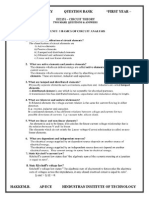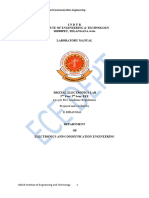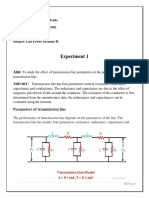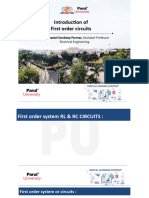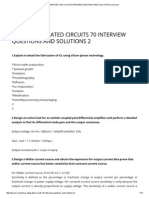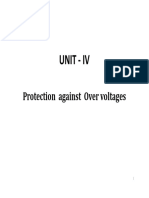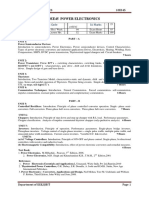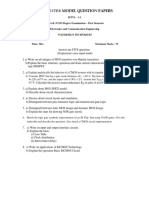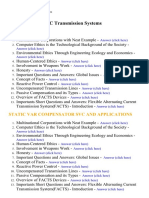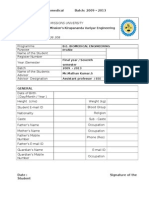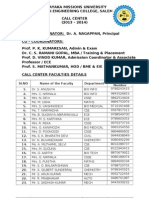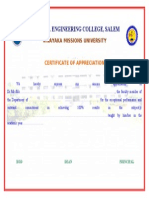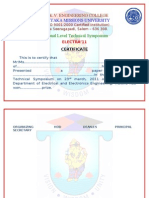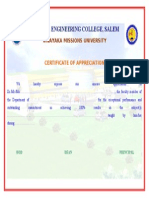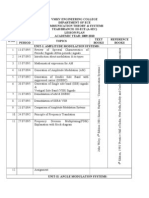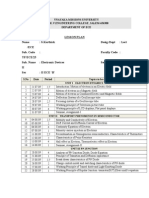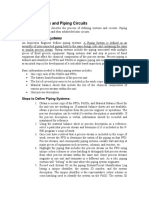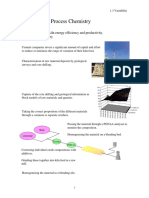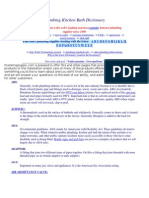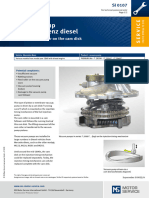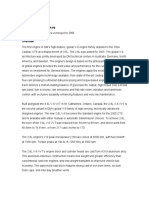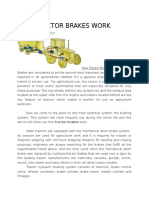Basic Electrical Engineering Assignment
Uploaded by
MATHANKUMAR.SBasic Electrical Engineering Assignment
Uploaded by
MATHANKUMAR.SAssignment
Batch: 2011 2015
VINAYAKA MISSIONS UNIVERSITY
Vinayaka Missions Kirupananda Variyar Engineering College
SALEM 636 308
First Year / Non Sem
Programme Subject Name Name of the Tutor Assignment. No. Date of Announcement
B.E. BASIC ELECTRICAL ENGINEERING Mr.Mathan Kumar.S 1 ** - ** - 2011
Year /Semester
Date of Submission
** ** 2011
PART A
Two (or) Three lines explanation / Short Answer / Short Calculation
1. Define charge, current and potential difference. 2. Define power. What is the relationship between power, voltage and current? 3. State Kirchhoffs law. 4. What is meant by active and passive element? 5. Write the basic concept of series and parallel circuit. 6. State ohms law. 7. What is a Series and parallel circuit? 8. Compare series and parallel circuit. 9. Give two applications of both series combination and parallel combination. 10. 11. What are the disadvantages of series circuit? What are the advantages of parallel circuits with applications?
12. Draw the symbolic representation of the voltage source and current source.
Signature of the Tutor EEE
Signature of the HOD /
Assignment
Batch: 2011 2015
13. Give the voltage and current equation for an AC through pure capacitance & inductance. 14. Draw the phasor diagram and waveform for a purely capacitive circuit & resistive circuit. 15. 16. What is circuit? What is power factor and reactive factor?
17. For the purely resistive circuit excited by sinusoidal varying voltage, what are the phase angle and power factor? 18. For the purely inductive circuit supplied by sinusoidal varying voltage, what is the phase relation between current and applied voltage. How are applied voltage and induced emf? 19. 20. Define apparent and reactive power. State Current division and Voltage division rule.
21. Two inductors with equal value of L are connected in series and parallel. What is the equivalent inductance? 22. Two inductors with equal value of C are connected in series and parallel. What is the equivalent capacitance? 23. What is meant by short and open circuits?
24. What is the voltage across a short circuit and what is the current through an open circuit? 25. Name the basic circuit law upon which the mesh method of circuit analysis is based? 26. Name the basic circuit law upon which the nodal method of circuit analysis is based? 27. What is the current - voltage relationship for capacitor? 28. 29. What is impedance diagram? What is the impedance of an RL and RC circuit?
Signature of the Tutor EEE
Signature of the HOD /
Assignment 30. 31. 32. 33. 34. What is power triangle? Define average value. Define complex power. Define RMS value. Define amplitude.
Batch: 2011 2015
35. Define cycle & frequency. 36. 37. 38. 39. 40. 41. 42. Define period. What is phasor diagram? Define Form and Peak factors. Draw the phasor diagram of RLC circuit. Draw the phasor diagram of RL and RC circuits. Define Resonance. Write down the series resonance frequency formula.
43. Why parallel resonance circuit is called rejecter circuit? 44. Why series resonance circuit is called accepter circuit? 45. 46. Define Quality factor. Which type of instrument is called as universal instrument?
47. Give the classifications of measuring instruments. 48. What are the advantages & disadvantages of PMMC instrument? 49. 50. 51. 52. What are the advantages of MI instrument? What are the operating forces needed for indicating instruments? What are the types of wattmeter? What is the use of megger?
Signature of the Tutor EEE
Signature of the HOD /
Assignment 53. 54.
Batch: 2011 2015
What are the errors occurred in MI instruments? How the Inductor Differed from the Capacitor?
55. What is the need of damping force? 56. 57. 58. List out the coils in wattmeter? What is the Need of Instrument? Define Error.
59. State the advantages and disadvantages of single phase energy meter. 60. Write down the classification of errors?
PART B
Descriptive ( Essay Type)
1. Briefly explain i) Kirchhoffs law ii) Series and parallel circuit 2. Find the Equivalent resistance and the current in the given circuit.
3 o h m 1 8 o h m 2 o h m
0 v
h m 8 o h m
3. i) Derive connected ii) Derive connected
the total inductance formula for two inductances are in parallel. the total resistance formula for three resistances are in parallel.
Signature of the Tutor EEE
Signature of the HOD /
Assignment
Batch: 2011 2015
4. A 50 resistor and a 75mH inductor are connected in series across a 400V, 50Hz supply. Find the impedance of the circuit, voltage across the resistor, voltage across the inductor, apparent power, active power and reactive power. 5. Derive an equation for Impedance (Z), Current (I), Power (P), Phase angle and Power factor in RLC circuit with its phasor diagram. 6. i) Two resistors are connected in parallel and a voltage of 240V is applied to the terminals, the total current is 15A and the power dissipated in one of the resistor is 2000W. What is the resistance of each element? ii) A 200W, 220V bulb is put in series with a 150W, 220V bulb across a 440V supply. What will be the current draw? What will be the power consumed by each bulb? Will such combination work? 7. Derive the current and power expression of AC through pure Resistance and Capacitance. 8. A 50Hz alternating voltage a 240V (rms) is applied independently to the i) Resistance of 75 ii) Inductance 0.75H iii) Capacitance of 75F. Find the expression of the instantaneous current in each case and draw phasor diagram in each case. 9. Explain the concept of voltage division and current division in an electric circuit with an example. 10. i) A bulb is rated at 220 V, 400W. Find the rated current, resistance of the filament and the energy consumed when it is operated for 15 hours. ii) An incandescent lamp is rated for 100V, 200W using suitable resistor how you can operate this lamp on 220V mains.
Signature of the Tutor EEE
Signature of the HOD /
Assignment
Batch: 2011 2015
11. i) A coil having a resistance of 40 and inductance of 0.75H forms part of series circuit, if the supply voltage is 250V, 50Hz. To Find the a) line current b) Power factor c) Voltage across the coil. ii) Derive the total capacitance formula for three capacitances are connected in Series. 12. Derive the impedance and power expression of AC through Series R-L Circuit with its phasor diagram. 13. Derive the impedance and power expression of AC through Series R-C Circuit with its phasor diagram. 14. Derive the current and power expression of AC through pure Inductance and also draw a V I characteristics curve. 15. A capacitor having a capacitance of 50F is connected in series with a non-inductive resistance of 150 across 240V, 60Hz. Calculate the current, power and phase difference between current and supply voltage. 16. Explain the Construction and Working of Attractive type moving iron instruments. List the merits and demerits. 17. With neat diagram explain the construction and working principle of Induction type Energy meter. 18. Briefly explain about Dynamometer wattmeter. List the merits and demerits. 19. Explain the construction and working principle of PMMC. 20. With neat diagram explain the operation of Repulsion type moving iron instrument. 21. Find the equivalent resistance using series and parallel combination in the network shown in Figure.
Signature of the Tutor EEE
Signature of the HOD /
Assignment
Batch: 2011 2015
22. Draw and explain the construction and working principle of Megger. List the merits and demerits. 23. Draw and explain any one type of the Moving Coil instruments. List the merits and demerits.













